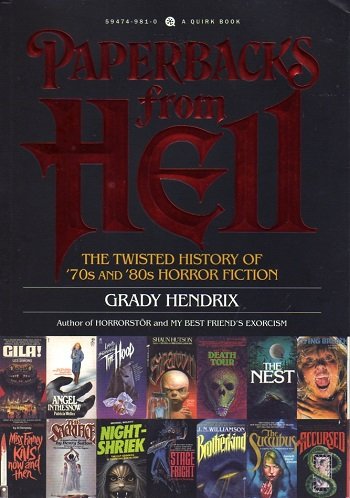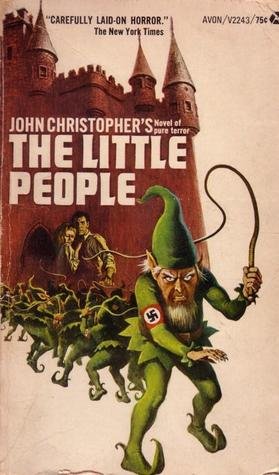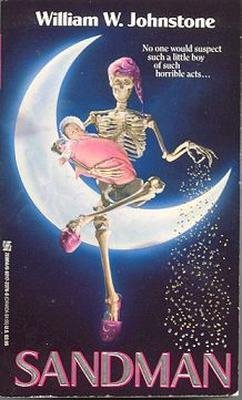Horror Review: Paperbacks From Hell by Grady Hendrix (2017, Quirk Books)

Please excuse my cover scan, as it can't possibly do the awesome red foil-embossed letters justice.
In 1981, a young man with a couple of novels published under his own name sat down at his typewriter and tried to make sense of humanity's seeming obsession with scaring ourselves. He looked back to his own childhood, and then even further, putting together the pieces of pop culture, books, films, television shows, and ghost stories to create a jagged, imperfect, but lovingly-crafted road map depicting the journeys of fear, horror, and terror into the late twentieth century. The book was Danse Macabre, its author an 'aw-shucks' sort of genteel writer who called Maine home named Stephen King.
Thirty-six years later, a young man with a couple of novels published under his own name sat down at his computer and tried to make sense of humanity's seeming obsession with scaring ourselves. He looked back to his own childhood, and then even further, putting together the pieces of pop culture, books, films, television shows, and ghost stories to create a jagged, imperfect, but lovingly-crafted road map depicting the journeys of fear, horror, and terror into the early twentieth century. The book was Paperbacks From Hell, its author a snarky, well-dressed sort of genteel writer who called New York home named Grady Hendrix.
Hendrix is a fascinating character in his own right, a guy who it seems is impossible to photograph unless he's wearing an all-white dress suit, who got started down the path of reading and reviewing out-of-print horror when he stumbled across a copy of John Christopher's The Little People in a dollar box at a science fiction convention:

Source: Goodreads
Nazi whip-wielding leprechauns were too good to pass up. Three months later, Hendrix read the book and realized that if there was this much insanity in one paperback horror book from the 1960's, there almost certainly was more. Hendrix threw himself into the madness, scouring used book stores, convention dealer tables, and the internet to acquire as many of these bizarre relics as he could. Tor hired him to produce regular articles about his findings for their website. After doing this for a few years, Hendrix realized there was a great, unwritten story to be told about these throwbacks with their lurid covers and promises of insanity, mayhem, and body parts on blurbs, which for three decades crowded bookshelves only to vanish when the bottom fell out of the market in the mid-90's. Thus, from the incredulity surrounding his discovery of a book populated by German-speaking, S&M-obsessed, Nazi-worshiping Gestappochauns, came Paperbacks From Hell.
Paperbacks From Hell is less an anthology of reviews than it is a cultural history written by a scholar with tongue lodged so firmly in cheek as to displace teeth. While Hendrix doesn't hesitate to wax loquacious on his feelings concerning dozens of books depicted within, the sheer volume of stuff he covers is overwhelmed by the amount of material he has to ignore. It's part history, part hysteria, and part twenty-first century musings on a twentieth century phenomenon.
If you're looking to understand "Horror" as a genre, Paperbacks From Hell isn't the place to start. There are plenty of more scholarly works, including King's aforementioned Danse Macabre, that tap that particular vein and go deeper. In fact, Paperbacks From Hell goes out of its way to ensure there's no way to confuse it with high-brow literary criticism by giving the big names of Horror little if any notice. There's no chapter here devoted to Stephen King or Richard Bachman. Dean Koontz barely merits mention. Anne Rice gets a couple of pages all her own, but that's just to explain how Interview With the Vampire made drinking blood and living forever seem sexy instead of nightmarish, ushering in a new era of vampire-themed fiction.
It isn't that Hendrix doesn't care about the likes of King, Rice, or Koontz. In fact, in a recent series for Tor, he completed a re-read of every King novel in chronological order and wrote about both the process of doing so and his thoughts on each book as he finished. It's that King, Rice, and Koontz occupy a literary tier above the focal point of Hendrix's microscope. Instead, starting with the "unholy triumvirate" of William Peter Blatty's The Exorcist, Thomas Tryon's The Other, and Ira Levin's Rosemary's Baby, Hendrix traces how these three novels went on to inspire countless rip-offs and me-too's with their themes of evil children, satanic panic, and righteous protagonists who don't always survive to see the final page turned.
Along the way he takes plenty of detours to recognize the top-notch cover work, often provided by uncredited artists and featuring 90's comic book levels of enhancements like foil, step-backs, and cut-outs that sought to entice readers to exchange hard-earned cash for lurid depictions of rape, violence, and nature run amok. As someone who spent his formative years in book shops where these covers often creeped me out, people my age are the obvious target for this wonderful tome, and though it spans 255 pages heavy with illustration, irony, and innuendo, there's no way Hendrix could cover everything within that limit. This isn't a horror encyclopedia, or some heavy-duty reference work like the myriad video review guides we no longer see on store shelves. It's a love letter to a very specific time in publishing history, where a certain laissez-faire, anything goes sentiment ruled the day and authors like William W. Johnstone, Ken Eulo, Leigh Clark, Ramsey Campbell, Andrew Neiderman, and J.N. Williamson plowed over reader sensibilities with their stories of satan-possessed towns, incestuous pairings, rampaging dinosaurs, and unhappy poltergeists.
If there's any justice in this world, Hendrix will publish a sequel to Paperbacks From Hell, or at least a spin-off collection of his remembrances and opinions of this time in horror fiction. The only truly glaring omission from my point of view is that Richard Laymon is overlooked completely despite his copious output having produced stories that would fit into virtually all of Hendrix's chapter breakdowns. But while Laymon might be the most conspicuously absent author, he's far from the only one, with plenty of lesser-known or completely forgotten writers glossed over as well. Not even every book presented on the front and back covers gets mentioned inside. But that's just the way things go.
Could Hendrix have made this thing five hundred pages? I suspect he could have done so easily. That he chose to limit himself to discussing the most outlandish, ridiculous, over-wrought, over-written, and short-sold books he could find speaks volumes of his ability as a writer to avoid biting off more than he could chew. I'm not sure that in his shoes I could do the same.
Regardless, if you're a modern-day horror fan looking for a serious, scholarly stab at what scares us and where it came from, grab Danse Macabre. If you just want to read about a time where mutant children spawned from incest-fueled relationships brought small town America to its knees; where nature red in tooth and claw tore into humanity via dogs, cats, rabbits, rats, cockroaches, and giant flesh-eating preying mantises; where every seemingly nice brownstone in New York was haunted by poltergeists; where doctors swapped cigarettes with their patients while persuading them to try for one of those new-fangled 'test-tube babies'; where serial killers stalk every alley, culvert, and basement; and where skeletons danced, performed surgery, and donned pink slippers while sitting on a crescent moon rocking a baby...well, then Paperbacks From Hell will be your gateway drug into a world you never knew you needed to visit, but will find yourself hard-pressed to leave.

Source: Goodreads
Five well-earned whacks of the 'crazy' stick out of five! Buy it today for the horror lover in your life.
I gave away my hardcover book club edition of Danse Macabre sometime in the mid-late 80s, sigh. I just didn't see it as that important of a book at the time. I really wish I had it back! I've not heard of Paperbacks From Hell but it sounds great. The lurid book covers were also used for true crime novels, which I went through like Kleenex in the 80s and 90s.
I just checked Amazon. The copy of Danse Macabre I had in the early 80s is now going for $150. Sigh.
You have been scouted by @promo-mentors. We are a community of new and veteran Steemians and we are always on the look out for promising authors.
I would like to invite you to our discord group https://discord.gg/vDPAFqb.
When you are there send me a message if you get lost! (My Discord name is the same as here on Steemit)